|
Laura and Dave reporting:
In early October, Bolton farmer Tucker Andrews and a dozen volunteers with TTJ’s Extra Row program made possible the following winter squash deliveries to local food shelves: 80 - Feeding Chittenden, Burlington 100- Williston Food Shelf 150 - Essex Jct United Church of Christ Heavenly Food Pantry 150 - Jericho-Underhill-Essex Ecumenical food shelf 120 - Janet S Munt Family Room, Burlington 80- Dot's Place, Essex In all, 680 squash at 1,200 lbs. were delivered. Things were a bit different this year. Because of the flooding, Tucker’s output was unusually low and he needed the extra row of squash for his own customers. He generously offered us a field to glean; we got great results and were able to assist many people in filling their food baskets. Was good to know the Extra Row program could provide some insurance for a farmer as well as feed people in need; this was a win-win situation for everyone! Besides us steering members, our volunteers included: Jeff York, Berta Frank, Bob Savaglio, Bill McMains, Amy Ludwin, Steve Ludwin, Sharon Damkot, Valerie Wilkins and Dean Wilkins. Thanks to all! Summer Wrap-Up...Fall is Here!
Laura reporting: Though quiet lately in blogland, there have been plenty of goings on within Transition Town Jericho...read on! Kids Gardening This summer we held our second annual Kids Garden Contest and volunteers led by Dave Clift set up about ten gardens for kids and their families. We’re awaiting survey results on how the growing season went for these kiddos; look for survey results and delightful pictures in an upcoming blog report! Food Hub Task Force This is a town-ordained offshoot of TTJ, and after a first meeting in late spring, we’ve been meeting monthly, talking about all things food/growing/farming related in Jericho. In August, we tabled at a Jericho Farmer’s Market, taking a survey to find out Jericho residents’ thoughts on buying and consuming local food. This survey is ongoing; check out the Food Hub Initiative page on this website to fill one out! Our task force personnel has since evolved from the original group, but continues to attract enthusiastic supporters and organizers. Our first project is underway; getting a community dinner going that will in some form or fashion feature our local farmers and their amazing produce; we’ll keep you posted! Extra Row Now in its third year, this program provides volunteers to help farmers who grow food for donation. In late August, we organized a crew to pick yellow beans at the Barber Farm fields of Charlie Siegchrist. He delivered the six or so bushels to the Vermont Youth Conservation Corps which distributes csa shares to families in need all over Vermont. And early this morning about a dozen folks showed up to glean winter squash at the Bolton fields of Tucker Andrews. The many pounds of squash gathered will be distributed to food pantries in Jericho, Williston, Burlington and Essex. Tree Celebration Edible Landscape’s Ann Gnagey and Tom Baribault are hosting a Tree Celebration at the Jericho Town Library on this last day of September, which includes children’s art and poetry around trees as well as education on how to maintain tree health on our town green and beyond. Watch for an upcoming blog report on this great event! Resiliency Presentations TTJ remains true to its mission of educating our community on issues related to resiliency. Reed Sims will host our *October talk: Composting at Home - the Good, the Bad and the Beautiful. As Reed puts it “This will cover the joy, the science, the soil and garden benefits, and integrating composting into the family routine. There will be hands-on participation, recipe guidelines, and mature compost results to touch and smell. We’ll discuss compost’s role in preparing gardens for overwintering, and what to do if your compost appears to have failed. Bring all of your questions and share lessons learned by experience” *Check out the October Events Calendar for the where and when of TTJ and other community events! 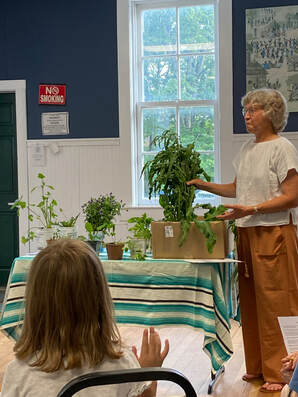 Laura here: On June 26, Chris Sims gave an insightful presentation at the JCC on common weeds that are edible and/or useful as medicines. The crowd of eighteen or so included a handful of children who eagerly took part in the plant ID quiz that kicked off the meeting. Plants were passed around so participants could get a visceral experience of each. Chris remembers as a young girl picking wild blueberries for pancakes and said she’s been hooked ever since! She brought some helpful books including her favorite from the 1980s, Edible Wild Plants of North America, A Field Guide. She started with some common sense precautions such as avoiding roadsides or areas where domestic animals roam and making sure the weeds haven’t been treated with pesticides. Chris focused on ten edibles that “grow and thrive in Jericho’s lawns and gardens”. Here are just a few highlights from her talk: Clover, both white and red are distinguished by triangle patterns (chevrons) on the leaves that actually help guide insects to the flower. The flowers are mildly sweet and the leaves should be eaten in moderation (and cooked) since they contain phytoestrogens. Curly dock, originally from Eurasia, is very prolific in Vermont. The young leaves can be eaten raw or cooked and oxalic acid gives it a lemony flavor. Once the seeds mature in late summer, they can be stripped from the stalk and ground into flour for breads, pancakes, etc. Dandelion: all parts of the familiar ‘lions tooth’ are edible with the flowers being the most nutritious; the pollen is considered a ‘superfood’. Young leaves can be eaten raw or cooked, though get bitter once the flowers buds start to form. Roots harvested in the spring, also before budding, can be roasted, ground and combined with other ingredients for a tasty beveridge. Johnny jump-ups: also known as wild pansies, these pretty purple flowers are edible in small quantities as they contain saponins which are toxic in large quantities. These flowers make a decorative garnish in a salad and are used as dye as well. Lambs quarters: A favorite of Chris’s, she says they’re a great substitute for spinach, especially with the vicissitudes of growing the latter! She said the leaves are best when cooked and brought along a yummy quiche made from lamb’s quarters and eggs for people to sample. When the plant is mature, she said you can collect the seeds to boil them and use in soups or for baking. Pigweed, in the amaranth family is another great substitute for spinach and Chris said the young leaves are tasty fresh, cooked or dried. Plantain as an edible is best when the leaves are young. They can be crushed or chewed to make a poultice for sunburn, skin ailments and insect bites. Purslane, identified by its rubbery thick leaves is highly nutritious and can be added to salads for both its flavor and crunchiness. Wild violet is identified by its heart shaped leaves. Blossoms can be used to make jelly or to beautify a salad. Yellow wood sorrel is a favorite among children as it’s easy and fun to identify. Flowers and leaves are edible in small quantities as the plant is high in oxalic acid. Often used to make a lemony iced tea. Dave here: Once again in 2023 TTJ, the Jericho Town Library and the Town of Jericho Select Board sponsored the Kids Garden Contest. After a successful garden season in 2022, we were excited to offer the program again. The purpose of the contest it to:
Not pictured is Evelyn and Amelia. Amelia wants to grow, strawberries for smoothies and Evelyn, Carrots for snacking and peppers, strawberries, basil, parsley, and cucumbers Dave, Chris, Laura and Anne enjoyed delivering the gardens which included a 4'x6' frame, 1/2 yard of garden soil, 7 wooden stakes, garden cover and a watering can!
Congratulations to our garden recipients and we look forward to meeting up with them again in late summer to see how their gardens grew. 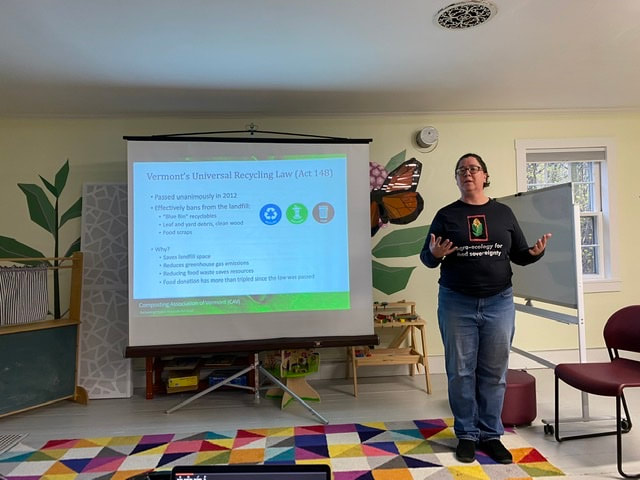 Laura here: If anyone can give a motivational talk on composting, it’s Natasha Duarte of the Composting Association of Vermont (CAV). On April 24, she gave a presentation on composting to transition town folks at the Jericho Town Library. Natasha is on a one person crusade to transform composting “from a solid waste management issue to something we can all utilize,” as she puts it. A nonprofit, CAV manifests the idea that composting in communities will improve soil health, water quality and resilience to climate change. Act 148 Act 148 which passed the Vermont legislature unanimously in 2012, established a timeline of diverting various materials from our landfills, culminating with food scraps which were banned in July 2020. This statewide law is the only one of its kind in the US. Previous to Act 148, food scraps made up about one quarter of the waste stream going into Vermont landfills. Vermonters currently have four options for dealing with food waste: -Haul the food scraps (a growing field, there are about 45 haulers in Jericho alone) -Bring to a drop off site -Compost at home -Compost in a community group Home & Community Composting Of the last two composting options, Natasha says, “the real place of power is to manage it (compost) yourself and/or within your community, and reap the benefits!” She explained that there are less contaminants, a lower carbon footprint (less trucking) and the end product is compost for personal and community usage. With community collaboration, there is a larger volume of food scraps thus making it easier to produce good compost. And while there may be challenges organizationally, you are “building social mycelia,” as Natasha puts it. Examples of communal composting in Vermont are various community gardens throughout the state, the VNA family room and Champlain Valley co-housing. UVM Extension now offers a Master Composter program and graduates from there can be helpful in organizing community composting efforts. CAV itself offers a free Community Composting self-guided training. Compost Recipe Natasha described compost as a “controlled aerobic (air-loving) biological process”. She provided a simple recipe for making compost: one part greens (food scraps, grass, manure) to three parts browns (wood, leaves, paper, straw). Turning it periodically is optional though generating enough heat is vital, 131 degrees being the ideal. Without too much effort, compost should be ready in 12-18 months. Natasha recommended having two bins to ensure a ready supply, saying the end product should smell like dirt and have the consistency of a damp sponge. Wildlife Challenge One of the biggest challenges in composting is the vermin challenge (yours truly once encountered a rat when turning her pile!) Natasha recommends following any of these options: covering food scraps with brown materials or soil; wood shavings or a little bit of lime to control odors; one-eighth inch wire mesh under and around the sides of the bin; in general, staying on top of the browns (carbon) in your pile. Vermont Organics Recycling Summit CAV hosts a free five-day event from May 1-5 that covers everything from compost co-ops to jumping worms to a compost-to-kitchen tour of Philo Ridge Farm. To find out more about the summit and all things CAV, go to: www.compostingvermont.org Laura M reporting:
Our TTJ team is pleased to announce the following resolution was passed on March 7 at Town Meeting: “We the citizens of Jericho propose the formation of Jericho as a vital Food Hub for the citizens of its Town and environs. A Food Task Force will be established by the SelectBoard, with the goal of increasing food self-sufficiency via the production, manufacture and distribution of local food.” A dozen or so local folks have offered to serve on the newly formed Food Task Force and we’ll be reporting on our progress here so...stay tuned! *** On March 27, Laura Oliver of the Jericho Seed Library presented: Starting Seeds with Ease. An ample crowd of about 25 people of all ages showed up at the Community Center for this informative talk and discussion. Check out the Seed Starting talk Laura Oliver gave last year for some seed starting basics: www.transitiontownjericho.net/blog/archives/03-2022 Some additional information she offered at this year’s talk: Containers Laura still recommends soil blockers as her first choice in starting seeds. She outlined several advantages, adding that there is a soil blocker at the Jericho Seed Library that can be checked out. She did a demonstration of filling the blocks; the soil needs to be wetter than with other methods (water oozing out when you squeeze it) She said the second best method is a wind strip tray; made of hard plastic, it comes in different sizes, allows air circulation around seedlings and is indestructible! Potting Soil For a high quality potting mix for starting seeds, Laura recommended Vermont Compost Company’s Fort Vee mix. She said you can make your own starter mix by combining the following: ten parts peat, ten parts compost and seven parts perlite. Heating Mats Laura said these mats are one of the best investments for seed starting. These are placed under the trays and simulate warmer temperatures. As soon as the seeds sprout, the seedlings can be placed under lights, thereby freeing the mats for starting additional seeds. Gardening Supplies Guy’s Farm and Yard is Laura’s first choice for purchasing garden supplies. There are four stores- the nearest one to Jericho is in Williston. Seedlings v. Direct Sowing After conducting a few home trials, Laura determined that direct planting is best for delicate seedlings such as cucumber, squash and pumpkins. She says they tend to be less stressed than transplanted seedlings; good advice from a pro! Terminology Stratification is treating seeds to simulate overwintering conditions. Laura described a method of stratifying overwintered herbs by filling (used) milk jugs with soil and the herbs, then placing them in the snow January and February to prepare them for planting in the earth come spring. Scarification is breaking down (large) seeds to stimulate germination. Laura said examples are nicking the seed or soaking it in water. Seed and Plant Swap Laura announced an upcoming Seed and Plant Swap (Saturday May 27 from 9:30am to 3:30pm at the Community Center) as a great way to swap your extra seedlings and seeds for others you’re in need of. Mark those calendars! *** Kids Garden Contest This is the second year TTJ is hosting the Kids Garden Contest. Ten raised garden beds, along with materials and supplies will be awarded and delivered to ten families by Mother’s Day. To earn a garden, children ages 6-13 need to fill out a creative questionnaire which gets them thinking about what they would grow and why. Forms are available at the Jericho Town Library, or can be requested via [email protected] Deadline is April 29. 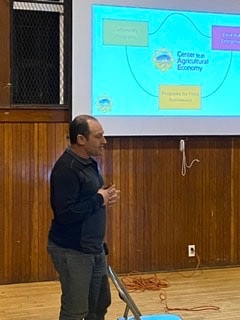 Laura reporting: Jon Ramsay, executive director of the Center for an Agricultural Economy (CAE) in Hardwick gave a presentation at the JCC on February 20 in Part 2 of “A Food Hub in Jericho...What If”. Jon’s talk was animated, and his enthusiasm well deserved as CAE is a multi-faceted food hub that’s made quite an impact on food resiliency in Hardwick and across the state. Next year marks the 20th anniversary of the nonprofit, which currently employs 31 people. Jon began by acknowledging the confusion around what a food hub actually is, due to the wide range of food hubs out there. CAE for example, runs several food hub enterprises: 1-Farm Connex, a truck delivery service, that Jericho Settlers and numerous other large and small farms in Vermont utilize; 2- Just Cut, which processes produce and delivers it to schools, hospitals and institutions around the state; 3-The Food Venture Center, which includes a commercial kitchen, communal dry and wet storage (half of the FVC is rented to their anchor tenant, Jasper Hill Cheese). CAE oversees several community programs in Hardwick which include: -Grow Your Own, hosting monthly skill-sharing workshops; as Jon says, “bringing the community together around food...people can share the awesome skills they have”. CAE owns 15 acres in which they oversee a community orchard, farmers market, community gardens and hoop houses, as well as a pavilion for hosting community events. -Produce to Pantries targets small produce growers in Hardwick, creating a supply chain with minimal overhead while supplying food to people in need. -CAE also runs a place-based education program, whose coordinator has set up a program at the local high school called ‘Recipe for Human Connection’. Here, students are encouraged to lead a variety of activities; gleaning at a local farm and making a community meal, or helping out at the elementary school’s community garden for example. Building leadership skills while supporting local food resiliency- a win-win! Comments from the 15 or so of us in the audience were indicators of specific concerns and needs in our locale. Laurel Shelmandine formerly of “It’s Arthur’s Fault”, said that supporting a food business in a home kitchen simply isn’t financially feasible; Ben Danowitz said he would love to start a small farm in Jericho and expressed frustration over zoning laws that preclude his living on the farm, thus making it affordable; Chris Simms commented that there are so many food hub models provided by CAE; we need to find which model(s) address the specific needs of our community. Catch the entire February 20th presentation here: https://archive.org/details/jericho-food-hub-02202023 Laura here:
Gearing up for the March 7 Town Meeting when TTJ is presenting a proposition around developing a food hub in Jericho as well as a new Food Commission to make it happen. Meanwhile, we’re hosting two community wide discussions around “A Food Hub in Jericho...What If?” I missed the first of meeting on January 30 (yes, battling covid!) but I watched the recording, filmed by Angelike Contis at MMC-TV. It’s quite informative with a real can-do spirit; a great resource for any group exploring food hubs. I’ll report some highlights here and urge you to check out the recording: https://archive.org/details/transition-town-jericho-food-hub-01302023 The meeting on January 30 was a panel-discussion at the Jericho Community Center and about 25 people showed up. Joanna Weinstock,organizer with the food shelf at Good Shepherd Church in Jericho was the first panelist. She shared some surprising statistics on how the pandemic increased the numbers of food-needy people in the area. Since pre-pandemic 2019, there has been a 44% increase in the number of clients. The food shelf used to average 43 families per month; now it’s 62 families. It serves Jericho and nearby towns, though nowadays people come from all over including Burlington, Starksboro, etc. Christa Alexander, co-owner of Jericho Settlers Farm already works with a couple existing food hubs (Intervale in Burlington and CAE in Hardwick). With 200 acres including two acres of hoop houses and greenhouses for year-round CSAS, they’re considered a medium to large farm for the area. While losing most of their restaurant contracts during the pandemic, their CSA shares increased from 150 to 300. Christa said they share the same goals as farm hubs around the state- how to make it easier for people to access local food. Sabina Ernst, serving on both Jericho’s Planning and Conservation Commissions said this could be good timing for initiating a Food Hub as the Ten-Year Town Plan for Jericho is being updated, and could include language around a Food Hub. Jericho still has a lot of open space that should be conserved for farming; she mentioned an agriculture subcommittee of the PC that’s working on that. Sabina is informed by having worked at an Edible Schoolyard years ago, believing that it all starts with kids; even just cooking with vegetables is a forgotten skill for many, she said. Joanna Doren is the local foods access coordinator at NOFA and was an important voice at last winter’s NOFA conference panel-discussion, “Building Food Sovereignty in Jericho”. She sees many advantages to food hubs, from people getting to know their local farmers, to sharing resources via a facility that offers processing and storage capability. She talked about a local food hub’s potential to “decentralize the labor and centralize the infrastructure.” Lindsey Berk is the executive director of ACORN Food Hub in Addison County. The pandemic helped us see the dangers of a globalized food system, she said and while ACORN tried to start a food hub in 2012, the pandemic is what got it off the ground, starting initially with an online market. She sees the six current food hubs in the state as unique from one another and stressed the importance of responding to what the community needs. Lindsey supported the idea of TTJ’s proposed Food Commission, saying it could be the first of its kind. Comments from the audience were supportive of the food hub idea, ranging from sheer excitement about the possibilities, to frustrations with the current lack of farmers at the Jericho Farmers Market to difficulties of supporting a family with the skyrocketing price of good, healthy food. Dave here: Transition Town Jericho and their volunteers have completed the picking and distribution of the butternut squash you grew for the Extra Row Project. The harvesting took about an hour, with 18 volunteers and a pick up truck Saturday October 1st. We piled them at the end of the row ready to distribute to local food shelves. Over the next 14 days the squash was distributed to local food shelves and other distribution points. Each squash was wiped down and counted as they were boxed for each distribution. The distribution was as follows, preceded by count of squash delivered: 500 Janet S. Munt Family Room 140 Jericho Underhill Food Shelf 125 Williston Food Shelf 30 Colchester Food shelf 130 Essex UCC church Heavenly Food Pantry 50 Aunt Dot's Place 10 Jericho Center food shed 40 Jeri-Hill Seniors 130 Feeding Chittenden (375 pounds) 1155 squash distributed, 3,234 pounds of squash, if the average weight is 2.8 lbs each. Special thanks to Jeff York and Heidi and Steve Klein for helping Dave and Laura transporting squash to distribution centers. Here are the squash as they are delivered and displayed, ready for taking home to eat!
Dave here: as a follow up to the Kids Garden Contest, Transition Town Jericho Team visited some of the winner's gardens in August and September to see how they did during this growing season. The kids were very excited to show off their gardens and tell the TTJ team about their experiences. Below are some pictures of the kids with their gardens and a few words about what they learned. 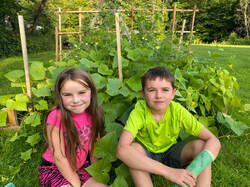 Aiden and Charlotte were very excited to show off their garden. Charlotte and Aiden had a healthy garden filled with Snap Peas, Cucumbers, Beans with some Marigolds and Cosmos flowers. The Snap Peas, and Beans were producing, and the first good sized cucumbers were harvested while we were visiting. Also was able to snack on pea pods and beans during the visit. They said they liked growing a garden and would do it again next year and would not do anything different next year, but maybe less flowers. Juniper grew Cherry and Large tomatoes, cucumbers and flowers. Oliver (not pictured) grew Hen and Chicks. They sold some of the vegetables at their farm stand along side the road. The proceeds go to the Smiley school. Juniper would tell others her age that gardening was pretty easy, and that they should do it too. Next year Juniper wants to do all flowers in her garden! Vera loved having a garden. She has her eye on a much larger piece of property, currently an overgrown field, that she wants to turn into flowers and start a business selling them. She definitely wants to garden next year, and she would definitely encourage her friends to give it a try. Kids garden visit with Ronin, Bodie, and Jackson (back to front), We were greeted by Viking helmeted very excited kids to show us their garden. They grew Dino Kale, red Russian Kale, Carrots, cucumbers, peas that were climbing up some string. They tried the square foot garden technique which was good early in the garden, but got too much growing in the space They liked growing the garden, especially the snap peas. Liked watching the cucumbers grow. Peppers in the middle of the garden were not growing well, maybe too crowded? Would like to plant a garden next year, would like to grow watermelon, pumpkin, carrots. Maddie referred to her garden as a jungle. The garden was well covered with dwarf sunflowers, much taller than she! She was also surprised that the garden got so crowded with all her plants. She had a lot of fun with the garden and will do it again next year. She would not allow the plants to spread and not plant as many wildflowers. Next year she will plant flowers to attract butterflies. Cally grew Arugula, Kale, lettuce, cherry tomatoes and lemon cucumber, as well as greens and Thai basil. she also grew Zinnia as well.
She found that using newspaper under the soil did a great job keeping the weeds down. Next year to grow more herbs in the garden as it is close to the kitchen and quickly accessible. Add lettuce and beets and little pumpkins. |
Click to set custom HTML
|
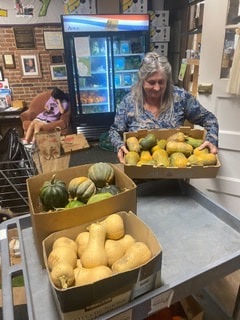
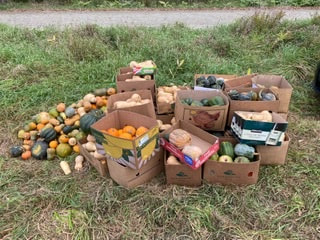
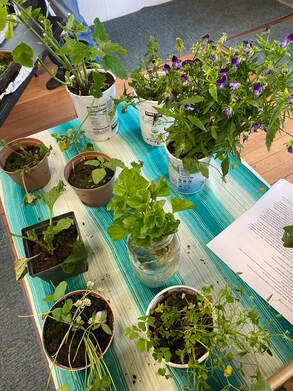
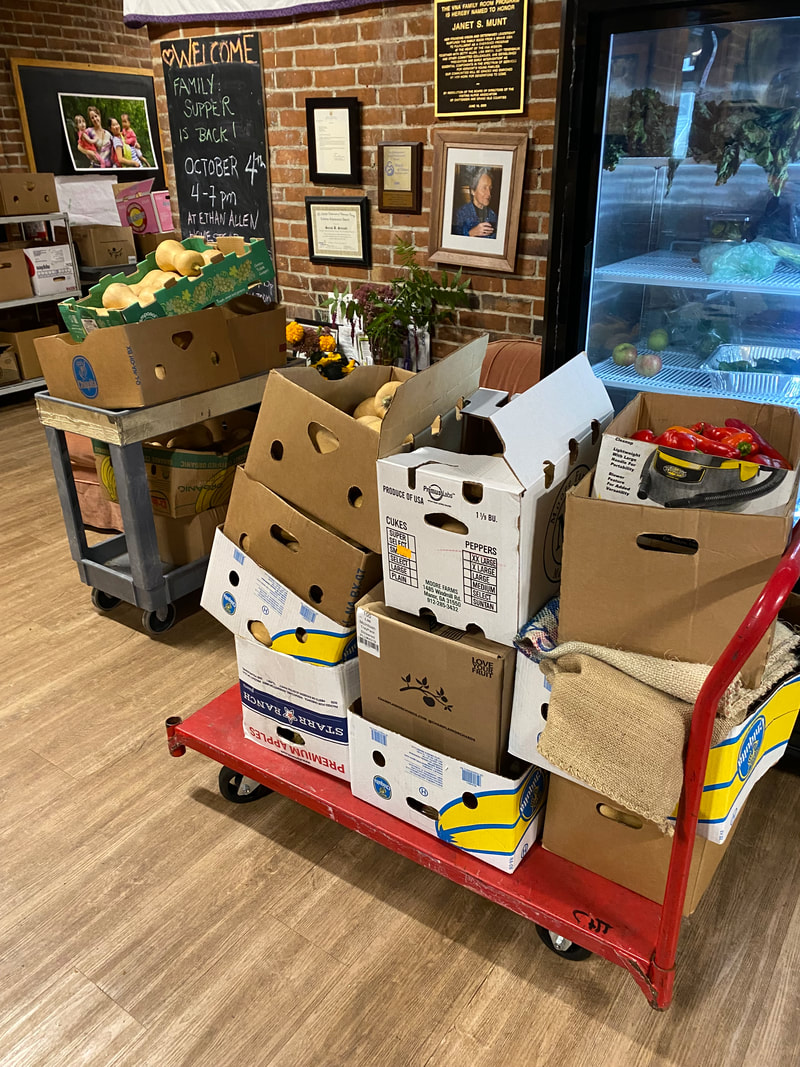
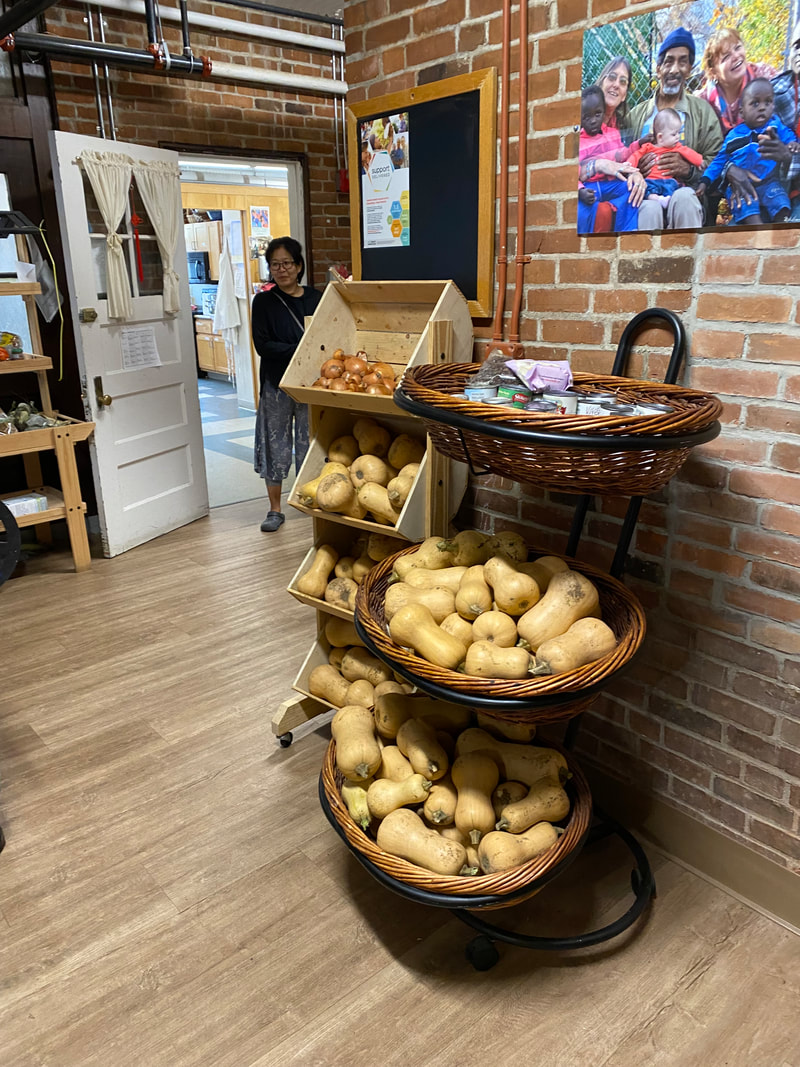
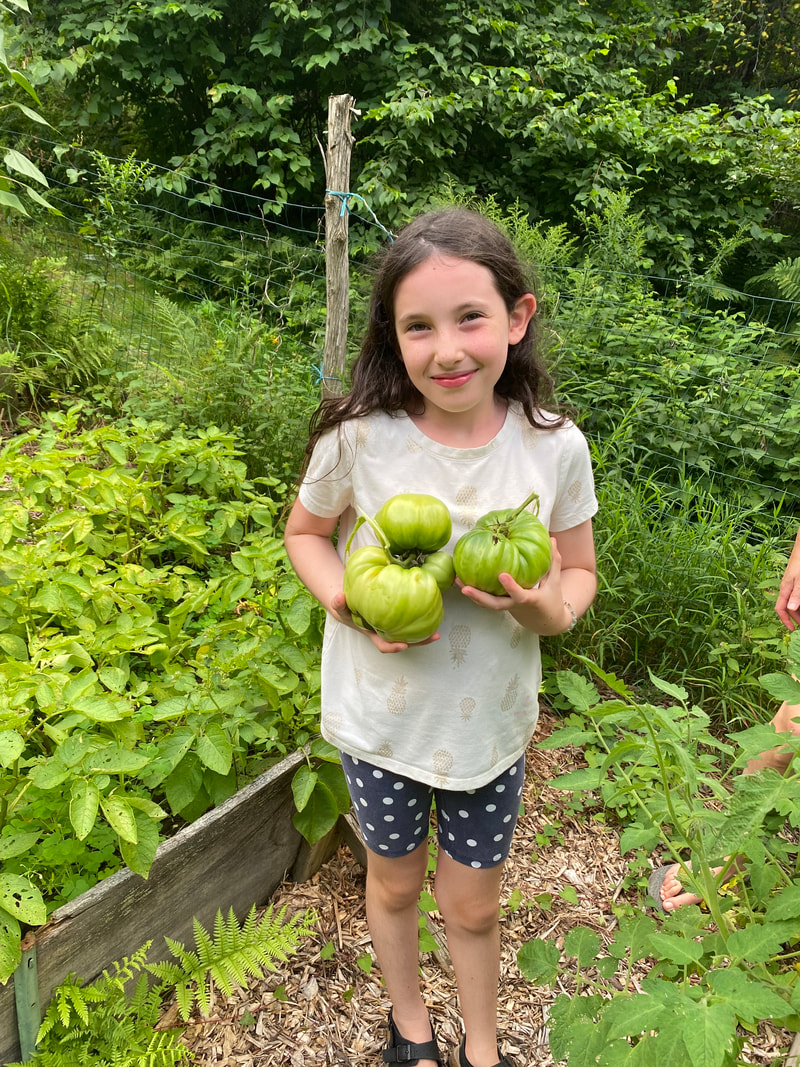
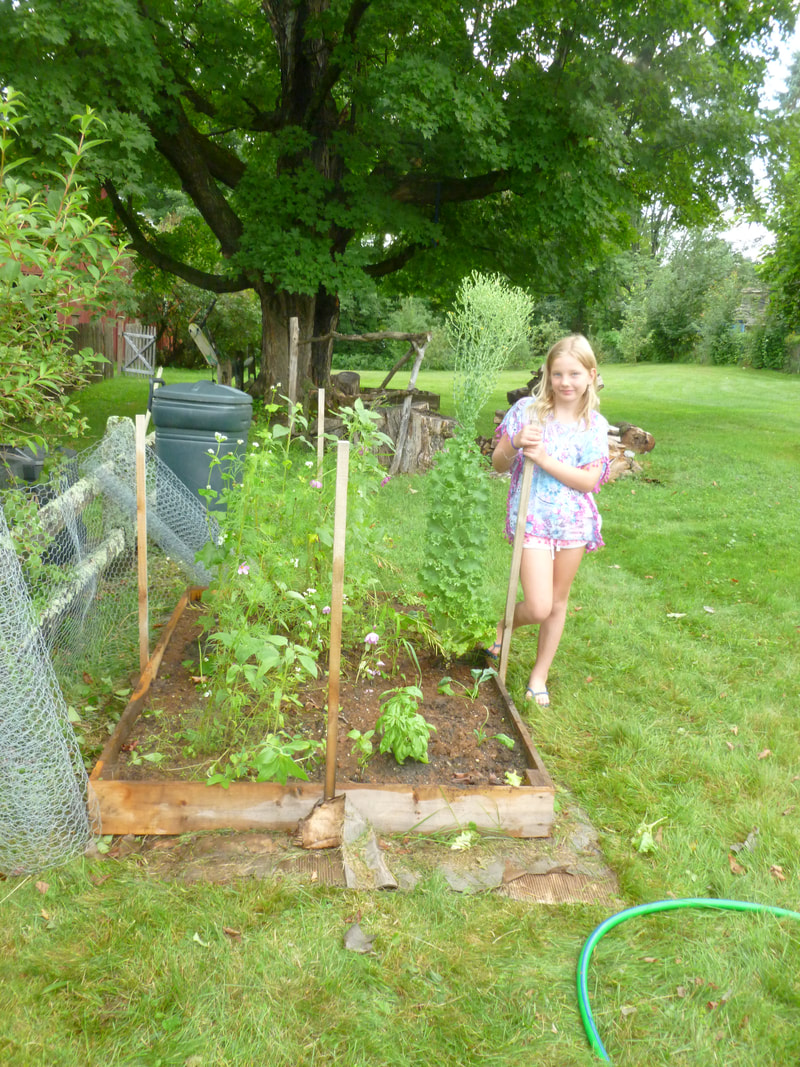
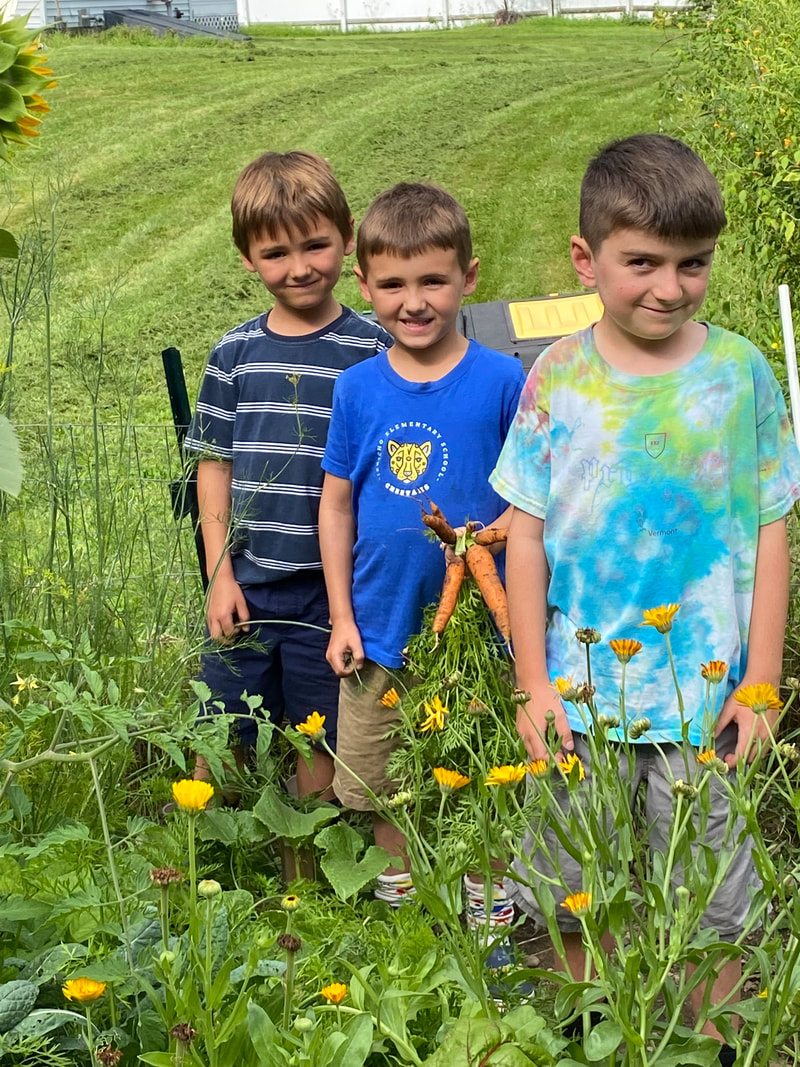
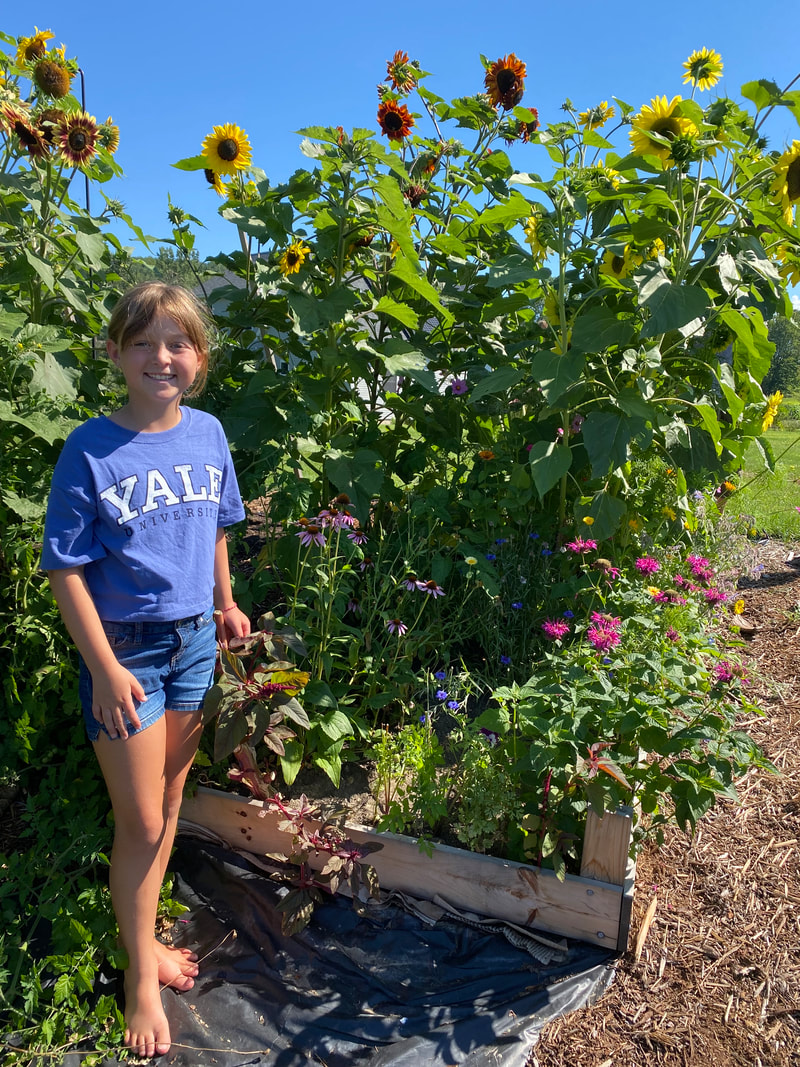
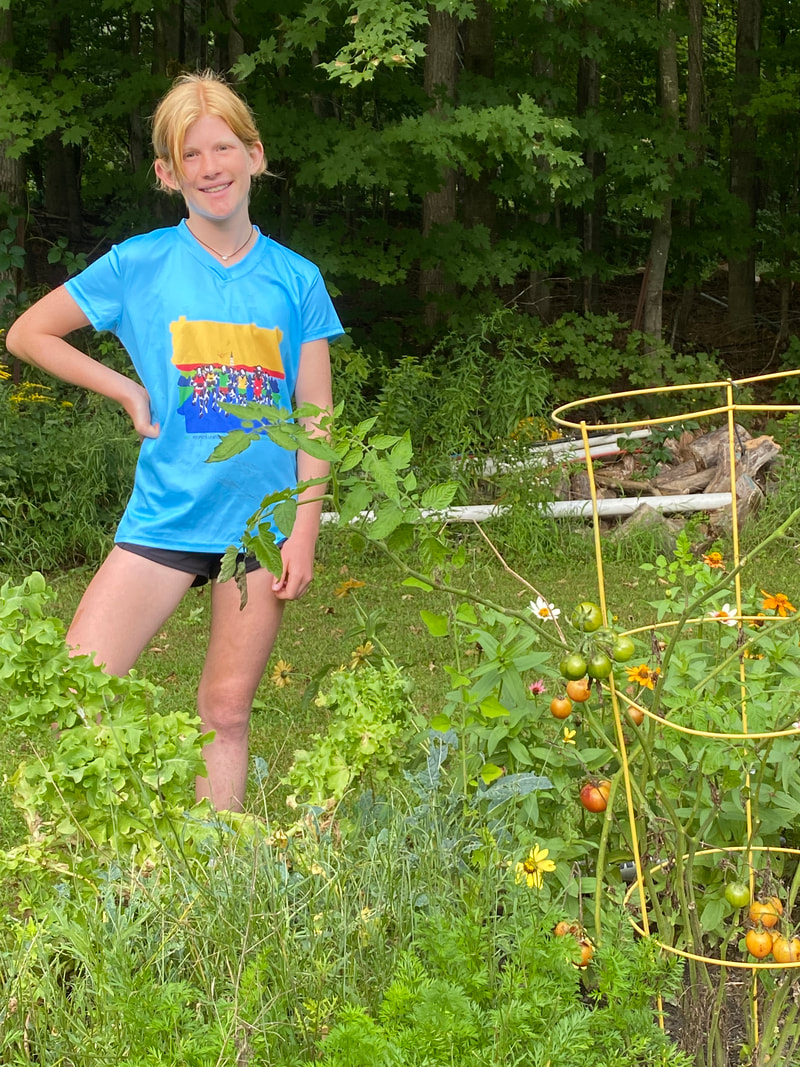
 RSS Feed
RSS Feed
